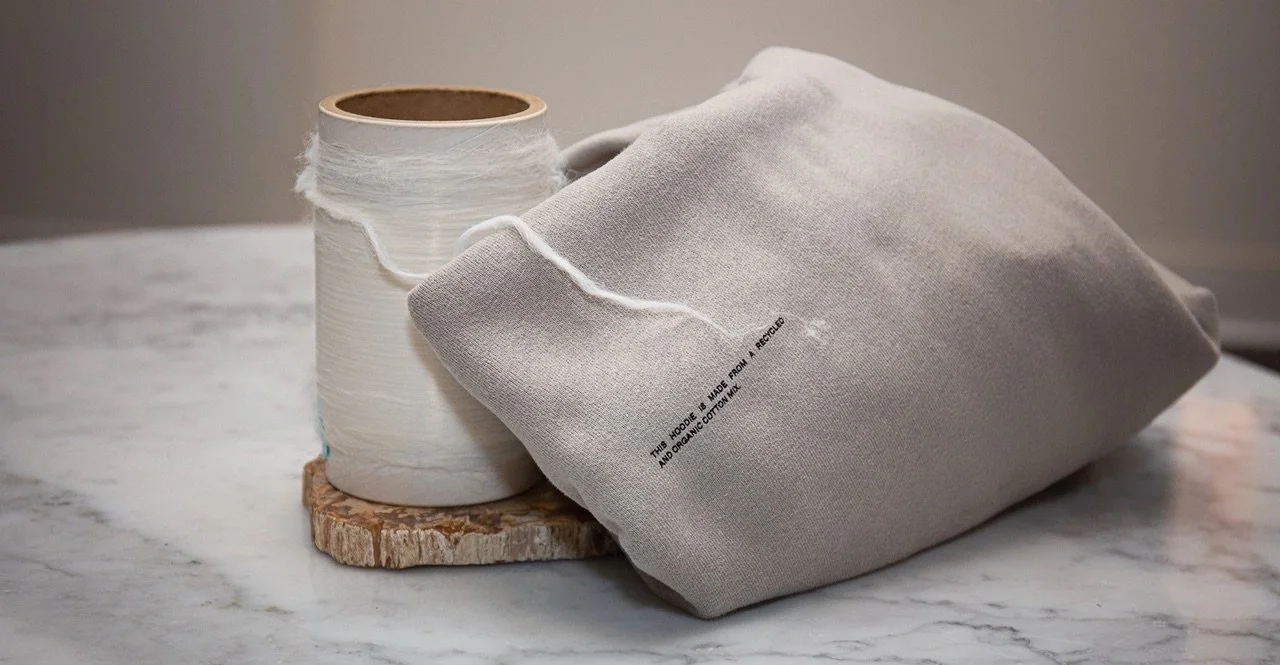How Elastane Kills Circularity (And Why It’s In Everything)
PANGAIA Invests in Kintra Fibers 100% Bio-Based and Compostable Yarns
If you’ve ever wondered why most of your clothes aren’t recyclable — even the “sustainable” ones — the answer is probably stretchy. Elastane. Spandex. Lycra. Whatever name it’s going by, it’s everywhere. And it’s quietly killing circularity in fashion.
That tiny percentage of stretch in your jeans or gym clothes? It might feel like nothing — but it’s the difference between a garment that can be recycled and one that’s destined for landfill.
So, What Is Elastane?
Elastane (aka spandex or Lycra) is a synthetic fiber that can stretch up to five times its original length. It’s lightweight, it snaps back into shape, and it only takes a few percentage points — like 2–5% — to make a noticeable difference in how a fabric moves and fits.
It’s the reason your jeans hug instead of sag. Why your sports bra holds instead of pinches. Why your loungewear has that perfect lived-in feel.
In short: elastane makes clothes feel better. And that’s exactly why it’s in everything.
But Here’s the Problem
Even in small amounts, elastane ruins the recyclability of clothing. It’s not biodegradable, it doesn’t separate easily from other fibers, and it behaves differently in processing — it melts at a lower temperature, gums up machines, and contaminates fiber streams.
So let’s say you’ve got a tee made of 95% organic cotton and 5% elastane. That 5% is enough to get the whole garment rejected from most recycling programs.
This means that even clothing made from “sustainable” materials can be rendered non-circular by just a little bit of stretch.
You can’t just wash elastane out. You can’t extract it. You can’t melt it into something else. It turns your entire garment into a dead end.
We’re Addicted to It — and For Good Reason
The hard truth is, consumers love elastane. So do brands. It makes garments:
More comfortable
More form-fitting
Less likely to wrinkle or stretch out
Easier to sell, faster to move, and less likely to be returned
In other words, elastane solves problems in the front half of the product life cycle. But it creates massive waste and recycling challenges on the back end.
It’s the ultimate short-term win / long-term loss trade-off.
Why This Is a Circularity Dealbreaker
Fashion is pushing circularity as a goal — from resale to rental to recycling — but you can’t build a circular system on products designed to not be recovered.
And yet, elastane is everywhere. From leggings to blouses to denim, even a “100% cotton” garment often has 2% stretch sewn in for fit. And once it’s in there, your options narrow drastically:
Mechanical recycling can’t process blends with elastane. The fibers jam up machines and degrade quality.
Chemical recycling doesn’t handle elastane well either — purity matters, and elastane messes with that.
Composting? Forget it. Elastane doesn’t break down. It just becomes microplastic.
So even the best recycling tech can’t fix what elastane ruins upfront.
Are There Alternatives?
This is where it gets interesting — and complicated. There are materials and design strategies that aim to replace or reduce elastane. But most aren’t perfect. Here’s what’s out there, and why adoption is still low:
A partially bio-based stretch fiber that decomposes in water and CO₂ under industrial composting conditions.
Certified by Cradle to Cradle and Bluesign.
Used by Houdini (outdoor brand) in their circular Mono Air garments.
Caveat: It’s still synthetic, and “decomposable” requires specific facilities that don’t exist in most markets.
2. Creora® Bio-Based by Hyosung
Made using 30% renewable resources (like corn-derived glucose).
Same performance as traditional spandex, but with a lower carbon footprint.
Brands like Pangaia have trialed it in activewear.
Caveat: Still not recyclable. Still not compostable. Still gets blended into poly or cotton garments, blocking circularity.
A newer startup creating a biodegradable, polyester-like stretch fiber from corn-derived sugars.
Breaks down in compost or marine environments without toxic residue.
Closed a funding round with backing from H&M Group Ventures, Ralph Lauren, and Allbirds.
Not yet scaled for mass adoption. Still in the pilot and partnership phase.
4. Design-Based Workarounds
Smart tailoring: Using darts, seams, and construction techniques to create flexibility without stretch.
Panel design: Some brands insert stretch only in key areas so the rest of the garment remains recyclable.
Modular components: Athos and others have explored replaceable elastic parts (think swappable waistbands).
The issue? These methods are often more labor-intensive, more expensive, and harder to scale under fast fashion economics.
So… Can Fashion Quit Elastane?
Not fully. Not yet.
The reality is, elastane is deeply embedded in modern fashion — not just in clothes, but in consumer psychology. We’ve come to expect comfort, flexibility, and that “perfect fit” stretch. For most people, “no stretch” = uncomfortable = no purchase. But circular fashion doesn’t stand a chance if we keep designing products that can't be recovered. So maybe the question isn’t how to quit elastane, but how to design systems around it — with honesty, strategy, and limits.
Some options:
Keep elastane where it makes sense: high-performance gear, intimates, and stretch-focused garments.
Avoid it in basics, tees, or everyday fashion that could otherwise be recyclable.
Stop calling elastane-blended clothes “sustainable” unless they come with a proven recovery system.
Because if it stretches now but can’t stretch into a second life — it’s not circular. It’s just elastic waste.

